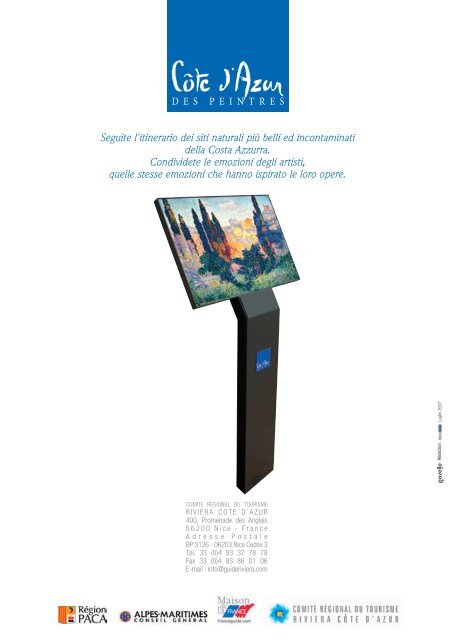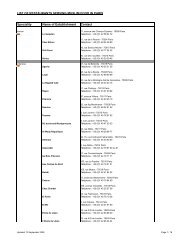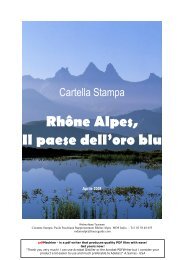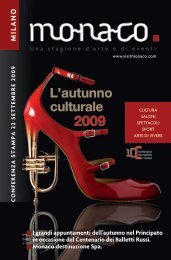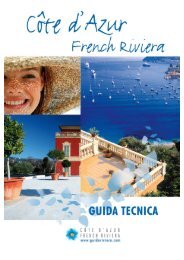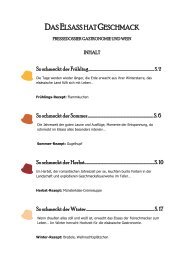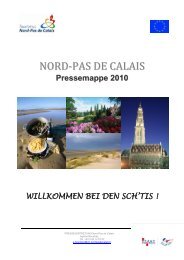Seguite l'itinerario dei siti naturali più belli - Maison de la France
Seguite l'itinerario dei siti naturali più belli - Maison de la France
Seguite l'itinerario dei siti naturali più belli - Maison de la France
You also want an ePaper? Increase the reach of your titles
YUMPU automatically turns print PDFs into web optimized ePapers that Google loves.
<strong>Seguite</strong> <strong>l'itinerario</strong> <strong><strong>de</strong>i</strong> <strong>siti</strong> <strong>naturali</strong> <strong>più</strong> <strong>belli</strong> ed incontaminati<br />
<strong>de</strong>l<strong>la</strong> Costa Azzurra.<br />
Condivi<strong>de</strong>te le emozioni <strong>de</strong>gli artisti,<br />
quelle stesse emozioni che hanno ispirato le loro opere.<br />
COMITE REGIONAL DU TOURISME<br />
RIVIERA COTE D’AZUR<br />
400, Promena<strong>de</strong> <strong>de</strong>s Ang<strong>la</strong>is<br />
06200 Nice - <strong>France</strong><br />
Adresse Postale<br />
BP 3126 - 06203 Nice Ce<strong>de</strong>x 3<br />
Tél. 33 (0)4 93 37 78 78<br />
Fax 33 (0)4 93 86 01 06<br />
E-mail : info@gui<strong>de</strong>riviera.com<br />
Rédaction : Luglio 2007
La Costa Azzurra <strong><strong>de</strong>i</strong> Pittori<br />
Sui passi <strong><strong>de</strong>i</strong> grandi maestri
2<br />
I pittori che<br />
hanno dipinto<br />
<strong>la</strong> Costa Azzurra<br />
•Pierre Bonnard, nasce nel 1867 a Fontenay-aux-Roses.<br />
Frequenta <strong>la</strong> scuo<strong>la</strong> di Belle Arti dove scopre <strong>la</strong> pittura di<br />
Paul Gauguin che lo influenzerà molto. In un secondo<br />
momento entra a far parte <strong>de</strong>l<strong>la</strong> corrente “Nabis” che esalta il<br />
colore e semplifica <strong>la</strong> forma.<br />
•Eugène Boudin, nasce nel 1824 a Honfleur. Nel 1849, si<br />
stabilisce a Parigi dove dipinge e frequenta Courbet e<br />
Monet che subiranno <strong>la</strong> sua influenza. Appassionato di<br />
viaggi, parte al<strong>la</strong> scoperta di molte regioni e si innamora<br />
<strong>de</strong>l<strong>la</strong> vita in mare.<br />
•Marc Chagall, di origine Biellorussa ma di famiglia ebrea,<br />
nasce nel 1887 e si stabilisce a Saint-Paul nel 1966. Maestro<br />
<strong>de</strong>l surrealismo <strong>la</strong>vora senza pausa fino al<strong>la</strong> sua morte nel<br />
1985.<br />
•Jean Cocteau, nasce nel 1889 a <strong>Maison</strong>-Laffitte. Poeta,<br />
disegnatore, grafico, autore di teatro, cineasta, consi<strong>de</strong>rato<br />
uno <strong><strong>de</strong>i</strong> maggiori artisti <strong>de</strong>l<strong>la</strong> sua epoca.<br />
•Henri-Edmond Cross (<strong>de</strong>tto), H.E. De<strong>la</strong>croix, nasce<br />
nel 1856 a Douai, a<strong>de</strong>risce al<strong>la</strong> corrente “puntinista”. Usa<br />
i colori accesi creando nell’insieme opere luminose e<br />
vivaci.<br />
•Emile Charles Dameron, un pittore paesaggista, nasce<br />
nel 1848 a Saumur-en-Auxois. Si avvicina molto allo stile<br />
Barbizon che celebra nel<strong>la</strong> pittura <strong>la</strong> natura.<br />
•Ferdinand Deconchy, nasce nel 1859 a Parigi. Dopo gli<br />
studi in architettura, si orienta verso <strong>la</strong> pittura e familiarizza in<br />
modo partico<strong>la</strong>re con quel<strong>la</strong> di C<strong>la</strong>u<strong>de</strong> Monet. Nel 1884, si<br />
stabilisce in Costa Azzurra ed è lui che all'inizio <strong>de</strong>l XX o<br />
secolo convince Renoir a stabilirsi a Cagnes-sur-Mer.<br />
•André Derain, nasce nel 1880 nell’Ile-<strong>de</strong>-<strong>France</strong>.<br />
Insieme a Matisse contribuisce al<strong>la</strong> nascita <strong>de</strong>l fauvismo.<br />
Dal 1906 in poi <strong>la</strong> sua pittura risente <strong>de</strong>ll’influenza di<br />
Gauguin e <strong>de</strong>ll’incontro con artisti come Picasso, Braque,<br />
o ancora Apollinaire.<br />
•Raoul Dufy, nasce nel 1877 a Havre. Scopre il fauvismo<br />
che poi abbandona per seguire <strong>la</strong> tecnica usata da Paul<br />
Cézanne. Nel 1911 sposa una giovane nizzarda e scopre<br />
<strong>la</strong> Costa Azzurra.<br />
•Adolphe Fioupou, nasce nel 1824 a Le Cannet. Cannes<br />
e <strong>la</strong> Costa <strong>de</strong>ll’Estérel diventano <strong>la</strong> sua principale fonte<br />
d’ispirazione. Fu un ufficiale <strong>de</strong>ll’acca<strong>de</strong>mia, ma allo<br />
stesso tempo uno <strong><strong>de</strong>i</strong> migliori allievi <strong>de</strong>l Contini capace di<br />
valorizzare i paesaggi <strong>de</strong>l<strong>la</strong> sua regione.<br />
•Maurice Frido, nasce nel 1926 a Parigi. Oggi vive ad<br />
Ascona ma adora da sempre Mentone. In un primo<br />
momento subisce l’influenza di Ignace Rubinstein. Worms,<br />
Brayer e Bezombes sono i suoi maestri. Oggi è membro<br />
<strong>de</strong>ll’Unione Nazionale <strong>de</strong>gli Artisti <strong>France</strong>si e<br />
<strong>de</strong>ll’Associazione <strong>de</strong>lle Belle Arti di Lugano.<br />
•Maurice Gottlob, nasce a Parigi nel 1885, muove i suoi<br />
primi passi nel<strong>la</strong> scultura, con le statue di Mistinguett o<br />
Charlie Chaplin. Poi si <strong>la</strong>scia sedurre dal<strong>la</strong> pittura e dipinge<br />
i vecchi quartieri di Parigi, infine si stabilisce a Mougins<br />
dove continua a ritrarre paesaggi e ritratti.<br />
•Jacques Guiaud, nasce nel 1810 a Chambéry. Nel 1847 si<br />
stabilisce a Nizza con <strong>la</strong> sua famiglia fino al 1860. Poi si<br />
trasferisce a Parigi ma ritorna rego<strong>la</strong>rmente nel<strong>la</strong> sua città di<br />
adozione fino al<strong>la</strong> sua morte.<br />
•Henri Harpignies, nasce nel 1819 a Valenciennes. Un<br />
pittore che celebra con straordinario realismo <strong>la</strong> dolcezza<br />
<strong><strong>de</strong>i</strong> paesaggi <strong>de</strong>l sud <strong>de</strong>l<strong>la</strong> Francia. Paesaggista di<br />
acquarelli, fu soprannominato da Anatole <strong>France</strong> il<br />
“Miche<strong>la</strong>ngelo <strong>de</strong>gli alberi”.<br />
•Armand Ingenbleek, nasce in Alsazia nel 1896.<br />
Appartiene al movimento <strong><strong>de</strong>i</strong> pittori alsaziani, un<br />
movimento molto vicino all'impressionismo. Amico <strong>de</strong>l<br />
celebre Hansi, esprime le sue visioni attraverso colori<br />
contrastanti.<br />
•Joseph Inguimberty, nasce a Marsiglia nel 1896.<br />
Dal 1925 al 1946 dirige l'Acca<strong>de</strong>mia <strong>de</strong>lle Belle Arti di<br />
Hanoï dove crea una sezione tutta <strong>de</strong>dicata al<strong>la</strong> tecnica<br />
e all'arte <strong>de</strong>l<strong>la</strong> <strong>la</strong>cca. Al suo ritorno in Francia trova<br />
l'ispirazione nei paesaggi e nel<strong>la</strong> natura di Mentone<br />
partecipando alle mostre <strong>più</strong> importanti <strong>de</strong>ll'epoca.<br />
•William H. Johnson, pittore americano di colore che<br />
nasce nel 1901. Segue una tradizione di espressione<br />
religiosa nel<strong>la</strong> comunità afroamericana. Un artista<br />
poliedrico, che vive per molto tempo in Europa condivi<strong>de</strong>ndo<br />
<strong>la</strong> vita con numerosi pittori avanguardisti.<br />
•Louis-Ernest Lessieux, nasce a La Rochelle nel 1848.<br />
Dopo un soggiorno a Mentone, ottiene il mercato <strong>de</strong>l<strong>la</strong><br />
Compagnia Generale <strong><strong>de</strong>i</strong> Transat<strong>la</strong>ntici… Si stabilisce<br />
quindi a Mentone nel 1897 dove insegna disegno al<strong>la</strong><br />
comunità inglese resi<strong>de</strong>nte sul<strong>la</strong> Costa Azzurra.<br />
•Henri Matisse, nasce nel 1869 nel Nord <strong>de</strong>l<strong>la</strong> Francia.<br />
L’uso di colori vivaci nei suoi dipinti lo consacrano come il<br />
capostipite <strong>de</strong>l fauvismo. A 48 anni si stabilisce a Nizza<br />
dove resta fino al<strong>la</strong> sua morte avvenuta nel 1954, all'età<br />
di 84 anni.<br />
•Jean-Louis Ernest Meissonier, nasce nel 1815 a<br />
Lione. Le sue pitture sono tra le <strong>più</strong> quotate <strong>de</strong>l XIX o<br />
secolo. Rappresenta perfettamente <strong>la</strong> corrente artistica<br />
acca<strong>de</strong>mica.<br />
•C<strong>la</strong>u<strong>de</strong> Monet, nasce nel 1840 a Parigi. Intorno al 1860<br />
crea un nuovo genere e ne diventa il capostipite:<br />
l'impressionismo. Poco a poco, acquista una certa notorietà<br />
grazie anche alle critiche.<br />
•Charles Nègre, nasce nel 1820 a Grasse. Rimane<br />
affascinato dai mestieri di strada e dall'attività umana. Dal<br />
1850 in poi, le sue ricerche lo portano ad esprimersi sempre<br />
di <strong>più</strong> attraverso <strong>la</strong> fotografia.<br />
•Yvon Peron, nasce a Parigi nel 1910. Di origine bretone,<br />
inizialmente diventa illustratore per alcune riviste, poi<br />
sceneggiatore cinematografico, autore di fumetti e<br />
infine stilista di moda (Grès, Balmain…). Dal 1950 si<br />
stabilisce a Grasse. Un pittore straordinario nell’uso<br />
<strong>de</strong>l<strong>la</strong> tecnica ad olio come nel<strong>la</strong> tempera o nel<br />
carboncino.<br />
•Raymond Peynet, nasce nel 1908 a Parigi. Studia al<strong>la</strong><br />
scuo<strong>la</strong> per le Arti Applicate dove opta per il disegno<br />
pubblicitario. Più tardi, immagina e crea il suo celebre<br />
personaggio: un piccolo violinista con il cappello rotondo al<br />
quale aggiunge ben presto <strong>la</strong> figura di una fragile<br />
compagna creando così i famosi “Innamorati di Peynet”.<br />
•Pablo Picasso, nasce nel 1881 a Ma<strong>la</strong>ga, fonda con<br />
Braque il movimento cubista. E’ uno <strong>de</strong>gli artisti <strong>più</strong><br />
rappresentativi <strong>de</strong>l XX° secolo. A 8 anni realizza le sue<br />
prime opere importanti. Dopo il periodo blu che va dal<br />
1901 al 1903, si stabilisce a Parigi, al bateau-<strong>la</strong>voir e<br />
inaugura il periodo rosa. Dal 1906, crea le sue prime tele<br />
“cubiste”. Dopo <strong>la</strong> guerra, si stabilisce sul<strong>la</strong> Costa Azzurra<br />
e le opere di quel periodo esprimono tutta <strong>la</strong> sua<br />
gioia di vivere. Dal 1973, Pablo Picasso riposa<br />
nel parco <strong>de</strong>l castello Vauvenargues, vicino a<br />
Aix-en-Provence.<br />
•Pierre Auguste Renoir, nasce nel 1841<br />
a Parigi. Amico di Sisley e di Monet,<br />
rimane affascinato dal<strong>la</strong> corrente<br />
impressionista. Poi, ritorna al disegno<br />
con un’attenzione costante per <strong>la</strong><br />
tecnica pittorica. Amante <strong>de</strong>l clima<br />
Mediterraneo si stabilisce aux<br />
“Colettes”a Cagnes-sur-Mer.<br />
•Chaïm Soutine, un pittore<br />
ebreo che nasce in un ghetto<br />
in Biellorussia nel 1893 e che<br />
conduce un'esistenza<br />
difficile. A 17 anni <strong>de</strong>ci<strong>de</strong> di<br />
partire per dipingere ed<br />
incontra Léger e Chagall,<br />
poi entra a far parte <strong>de</strong>l<br />
gruppo <strong><strong>de</strong>i</strong> Nabis.<br />
•Erwin Sutter, un<br />
pittore alzasiano che<br />
nasce nel 1897. Si<br />
stabilisce a Grasse nel 1932. Rimane<br />
profondamente colpito dal<strong>la</strong> guerra e<br />
a<strong>de</strong>risce al movimento espressionista.<br />
•Raymond Tournon, nasce nel 1870<br />
a Gail<strong>la</strong>c-su-Tarn. Negli anni 1920-<br />
1930 vive a Villefranche-sur-Mer dove<br />
apprezza <strong>la</strong> luce tipica di questa<br />
cittadina. Di cultura c<strong>la</strong>ssica,<br />
inizialmente fa il grafico ma a<strong>de</strong>risce<br />
poi al<strong>la</strong> corrente impressionista.<br />
•Félix Vallotton, nasce nel 1865 a<br />
Losanna, pittore ed incisore su legno.<br />
Esalta <strong>la</strong> bellezza <strong>de</strong>l<strong>la</strong> realtà che lo<br />
circonda, pren<strong>de</strong>ndosi gioco <strong>de</strong>lle forme<br />
e <strong><strong>de</strong>i</strong> colori. Dal 1910 rimane<br />
affascinato dai tramonti.<br />
•Emile Wery, nasce nel 1868 a Reims.<br />
Passato dall'acca<strong>de</strong>mia Jullian, amico di<br />
Dufy, di Emilio Othon Friesz ma<br />
soprattutto di Matisse con il quale<br />
viaggia e <strong>la</strong>vora tra gli anni 1895/96.<br />
Diventa celebre e apprezzato per i suoi<br />
ritratti mondani. La sua natura fu anche<br />
neoimpressionista. Si stabilisce a<br />
Cagnes-sur-Mer all'inizio <strong>de</strong>gli anni 20<br />
ed dipinge con magnifici affreschi i muri<br />
<strong>de</strong>ll’ hotel du Cagnard, vicinissimo a casa<br />
sua.<br />
Raoul Dufy (1877 - 1953)<br />
Vue <strong>de</strong> Grasse (intorno al 1930)<br />
Museo Nazionale d’Arte Mo<strong>de</strong>rna,<br />
Centro Georges Pompidou, Paris<br />
Haut-<strong>de</strong>-Cagnes, Cagnes-sur-Mer
Al<strong>la</strong> scoperta<br />
<strong>de</strong>llo spirito creativo…<br />
<strong>Seguite</strong> <strong>l'itinerario</strong> <strong><strong>de</strong>i</strong> <strong>siti</strong> <strong>naturali</strong> <strong>più</strong> <strong>belli</strong> ed incontaminati <strong>de</strong>l<strong>la</strong> Costa Azzurra. Condivi<strong>de</strong>te le<br />
emozioni <strong>de</strong>gli artisti, quelle stesse emozioni che hanno ispirato le loro opere. 9 comuni <strong>de</strong>l<br />
dipartimento <strong>de</strong>l<strong>la</strong> Costa Azzurra vi invitano, attraverso numerosi leggii, sistemati da poco e<br />
all’aria aperta, nei luoghi dove sono state create le opere originali di<br />
molti artisti, a seguire i passi di Picasso, Chagall, Monet, Renoir, Dufy,<br />
Cocteau, Bonnard, Derain, Cross, Soutine, Frido, Boudin, Peynet…<br />
“La Costa Azzurra <strong><strong>de</strong>i</strong> Pittori”, vi permette di<br />
guardare con occhi diversi i paesaggi <strong>naturali</strong>, le città<br />
e i vil<strong>la</strong>ggi <strong>de</strong>lle Alpi-Marittime, celebrati dal<strong>la</strong> pittura<br />
<strong><strong>de</strong>i</strong> Maggiori Artisti <strong>de</strong>ll’epoca.<br />
“Un giorno <strong>la</strong> bellezza che si cre<strong>de</strong>va eterna, cercò un luogo<br />
che non l’avrebbe mai <strong>de</strong>lusa. Scoprì <strong>la</strong> Costa Azzurra,<br />
si trasferì e si trovò bene. E da allora è lì che vive.”<br />
Louis Nucera, scrittore francese (1929-2000)<br />
Nizza<br />
3
Grasse<br />
Mougins<br />
Saint-Paul <strong>de</strong> Vence<br />
Le Cannet<br />
Cagnes-sur-Mer<br />
Cannes<br />
Nizza<br />
Antibes Juan-les-Pins<br />
Menton<br />
Villefranche-sur-Mer<br />
L’itinerario “La Costa Azzurra <strong><strong>de</strong>i</strong> Pittori” è stato creato dal CRT Riviera Côte<br />
d’Azur. Il progetto è stato realizzato grazie al<strong>la</strong> col<strong>la</strong>borazione e al<strong>la</strong> contributo<br />
significativo <strong>de</strong>l Consiglio Regionale Provenza Alpi Costa Azzurra, <strong>de</strong>l Consiglio<br />
Generale <strong>de</strong>lle Alpi Marittime e <strong>de</strong>lle città partner: Antibes Juan-les-Pins,<br />
Cagnes-sur-Mer, Cannes, Grasse, Le Cannet, Mentone, Mougins Saint-Paul-<strong>de</strong>-<br />
Vence e Villefranche-sur-Mer.<br />
4<br />
Antibes<br />
Juan-les-Pins Cagnes-sur-Mer<br />
Antibes effet d’après midi<br />
1888 C<strong>la</strong>u<strong>de</strong> Monet<br />
Passeggiata Pierre Merli-<br />
Ponteil/Salis<br />
Antibes vue <strong>de</strong> <strong>la</strong> Salis<br />
1888 C<strong>la</strong>u<strong>de</strong> Monet<br />
Cap d’Antibes<br />
Viale Bacone<br />
Antibes, le matin<br />
1888 C<strong>la</strong>u<strong>de</strong> Monet<br />
Cap d’Antibes<br />
Viale Bacone<br />
Antibes, Vue du P<strong>la</strong>teau<br />
Notre Dame<br />
1888 C<strong>la</strong>u<strong>de</strong> Monet<br />
Cap d’Antibes<br />
Davanti Vil<strong>la</strong> A. Bloch,<br />
Faro <strong>de</strong>l<strong>la</strong> Garoupe<br />
Le port d’Antibes<br />
1893 Eugène Boudin<br />
Punta <strong>de</strong>ll’Ilet<br />
Antibes<br />
1908 Henri-Edmond Cross<br />
(<strong>de</strong>tto), H.E. De<strong>la</strong>croix<br />
Piazza Albert 1°<br />
Antibes, <strong>la</strong> promena<strong>de</strong> à<br />
cheval, l’artiste et son fils<br />
Charles<br />
1868 Jean-Louis Ernest<br />
Meissonier<br />
Passeggiata Pierre Merli -<br />
Ponteil/Salis<br />
Le marché du Cours<br />
Masséna à Antibes<br />
Fine <strong>de</strong>l XIX o secolo<br />
Emile Charles Dameron<br />
Angolo tra via Sa<strong>de</strong> e Corso<br />
Masséna<br />
Antibes<br />
1888 Henri Harpignies<br />
Viale <strong>de</strong>l Cap<br />
(in cima alle scale)<br />
Les amoureux<br />
aux remparts<br />
1985 Raymond Peynet<br />
Punta <strong>de</strong>ll’Ilet<br />
Pêche <strong>de</strong> nuit<br />
à Antibes<br />
1939 Pablo Ruiz y Picasso<br />
Terrazza <strong>de</strong>l Bastione<br />
Saint-André, Museo di<br />
Storia e Archeologia<br />
Paysages <strong>de</strong> Cagnes<br />
1910 André Derain<br />
Haut-<strong>de</strong>-Cagnes<br />
Porta Saint-Paul<br />
Paysages <strong>de</strong>s Collettes<br />
1914 Pierre Auguste Renoir<br />
Giardini <strong>de</strong>l Museo Renoir<br />
La ferme <strong>de</strong>s Collettes<br />
1915 Pierre Auguste Renoir<br />
Giardini <strong>de</strong>l Museo Renoir<br />
La Montée <strong>de</strong> Cagnes<br />
1923/24 Chaïm Soutine<br />
Haut-<strong>de</strong>-Cagnes<br />
Nel parcheggio P<strong>la</strong>nastel<br />
Paysages <strong>de</strong> Cagnes<br />
1924 Chaïm Soutine<br />
Haut-<strong>de</strong>-Cagnes<br />
Salita <strong><strong>de</strong>i</strong> Caucours<br />
Paysages <strong>de</strong> Cagnes<br />
1923 Chaïm Soutine<br />
Haut-<strong>de</strong>-Cagnes<br />
Piazza Notre-Dame <strong>de</strong> <strong>la</strong><br />
Protection<br />
La Route <strong>de</strong> <strong>la</strong> Colline<br />
1922 Chaïm Soutine<br />
Haut-<strong>de</strong>-Cagnes<br />
Via Hippolyte Guis<br />
Cagnes-sur-Mer<br />
1926/29 William H. Johnson<br />
Haut-<strong>de</strong>-Cagnes<br />
Salita <strong>de</strong>l<strong>la</strong> Bourga<strong>de</strong><br />
Les cyprès à Cagnes<br />
1908 Henri-Edmond Cross (<strong>de</strong>tto),<br />
H.E. De<strong>la</strong>croix<br />
Haut-<strong>de</strong>-Cagnes<br />
Parcheggio Sainte-Anne<br />
Mimosas en fleurs à Cagnes<br />
1921 Félix Vallotton<br />
Haut-<strong>de</strong>-Cagnes<br />
Salita <strong>de</strong>l<strong>la</strong> Bourga<strong>de</strong><br />
Vieille rue <strong>de</strong> Cagnes,<br />
soleil couchant<br />
1920 Félix Vallotton<br />
Haut-<strong>de</strong>-Cagnes<br />
Mura Saint-Sébastien
Cannes<br />
Legii in corso di<br />
realizzazione<br />
Grasse<br />
Le Cannet<br />
Chapelle Notre Dame <strong>de</strong> <strong>la</strong><br />
Protection<br />
Intorno al 1900 Ferdinand Deconchy<br />
Haut-<strong>de</strong>-Cagnes<br />
Via Hippolyte Guis<br />
La Montée <strong>de</strong> <strong>la</strong> Bourga<strong>de</strong><br />
Emile Wery<br />
Haut-<strong>de</strong>-Cagnes<br />
Salita <strong>de</strong>l<strong>la</strong> Bourga<strong>de</strong><br />
P<strong>la</strong>ce du Haut <strong>de</strong> Cagnes<br />
en hiver<br />
1979 Monique Giresse<br />
Haut-<strong>de</strong>-Cagnes<br />
Piazza Castello<br />
Cannes, <strong>la</strong> Croisette<br />
1862 Adolphe Fioupou<br />
Vue <strong>de</strong> Grasse<br />
Intorno al 1930 Raoul Dufy<br />
Corso Honoré Cresp<br />
Le Quartier <strong>de</strong>s Moulins<br />
Intorno al 1860 Charles Nègre<br />
Piazza Pontet<br />
Rue <strong>de</strong> <strong>la</strong> Fontette<br />
1935 Erwin Sutter<br />
Via <strong>de</strong>l<strong>la</strong> Fontette<br />
Vue <strong>de</strong> Grasse<br />
1996 Yvon Peron<br />
Corso Honoré Cresp<br />
Ciel d’orage sur Cannes<br />
1945 Pierre Bonnard<br />
Chemin <strong>de</strong>s Collines<br />
Paysage du Cannet<br />
Intorno al 1927 Pierre Bonnard<br />
Giardini <strong>de</strong>ll’Hôtel <strong>de</strong> Ville<br />
La Route Rose<br />
1934 Pierre Bonnard<br />
30, avenue Victoria<br />
Ammirate i paesaggi che<br />
hanno ispirato gli artisti<br />
di ogni tempo<br />
Mentone<br />
Mougins<br />
Parvis Saint Michel<br />
Intorno al 1927 Raoul Dufy<br />
Sagrato Saint Michel<br />
La P<strong>la</strong>ce Saint Michel<br />
et les trois clochers<br />
1965 Joseph Inguimberty<br />
Sagrato Saint Michel<br />
Gran<strong>de</strong> vue <strong>de</strong> Menton<br />
2002 Maurice Frido<br />
Piazza <strong>de</strong>l cimitero <strong>de</strong>l Vieux Château<br />
Le port <strong>de</strong> Menton<br />
vu <strong>de</strong> <strong>la</strong> route d’Italie<br />
Ernest Louis Lessieux<br />
Belve<strong>de</strong>re <strong>de</strong>l Clos du Peyronnet<br />
Viale Garavan<br />
Barques et pêcheurs,<br />
baie est <strong>de</strong> Menton<br />
Ernest Louis Lessieux<br />
Stadio Ron<strong>de</strong>lli<br />
Paysage <strong>de</strong> Mougins II<br />
1965 Pablo Ruiz y Picasso<br />
Capel<strong>la</strong> Notre Dame <strong>de</strong> Vie<br />
L’étang <strong>de</strong> Mougins<br />
1948 Maurice Gottlob<br />
Stagno <strong>de</strong> Fontmerle<br />
Porte Sarrazine<br />
1930 Maurice Gottlob<br />
Porta Sarrazine<br />
Vil<strong>la</strong>ge <strong>de</strong> Mougins<br />
sous ciel nuageux<br />
1946 Maurice Gottlob<br />
Parcheggio davanti al centro amministrativo<br />
Saint-Paul<br />
<strong>de</strong>-Vence<br />
Villefranchesur-Mer<br />
Le couple dans le paysage bleu<br />
1969/71 Marc Chagall<br />
Via Colle-Carrefour Cal<strong>de</strong>r<br />
Couple au-<strong>de</strong>ssus<br />
<strong>de</strong> Saint Paul<br />
1968 Marc Chagall<br />
Chemin Sainte-C<strong>la</strong>ire<br />
La table <strong>de</strong>vant<br />
le vil<strong>la</strong>ge<br />
1968 Marc Chagall<br />
Chemin Sainte-C<strong>la</strong>ire<br />
Rue Obscure<br />
1956/57 Jean Cocteau<br />
Via Obscure<br />
Ra<strong>de</strong> <strong>de</strong> Villefranche<br />
1892 Eugène Boudin<br />
Passeggiata <strong>de</strong>s Marinières<br />
Vue <strong>de</strong> Villefranche<br />
1856 Jacques Guiaud<br />
Molo Amiral Courbet<br />
Les filets <strong>de</strong> Villefranche<br />
1918 Raymond Tournon<br />
Molo Amiral Courbet<br />
Fontaine à Villefranche<br />
1927 Armand Ingenbleek<br />
Piazza Félix Poul<strong>la</strong>n<br />
5
Mediterraneo<br />
6<br />
Il Mar Mediterraneo,<br />
orizzonte e fonte<br />
d’ispirazione <strong>de</strong>gli artisti…<br />
Ad ognuno il proprio tempo, ad ognuno il proprio sguardo. I pittori <strong>de</strong>l XIX o e <strong>de</strong>l XX o secolo catturano per sempre il<br />
movimento eterno <strong>de</strong>l mar mediterraneo. Pittori paesaggisti, pre-impressionisti, impressionisti, disegnatori, tutti<br />
rimangono affascinati e attratti dai paesaggi marittimi <strong>de</strong>l<strong>la</strong> Costa Azzurra.<br />
In questa natura incontaminata, dove il cielo e il mare si fondono, un invito a vivere le stesse emozioni che gli artisti<br />
hanno provano di fronte al mare mediterraneo, a volte calmo, a volte agitato ma sempre e comunque una fonte<br />
d’ispirazione esaltante.<br />
Pren<strong>de</strong>tevi il tempo di una passeggiata sul Cap di Antibes, scoprite i panorami mozzafiato di Cap Ferrat, <strong>la</strong>sciatevi<br />
cul<strong>la</strong>re dalle on<strong>de</strong> e inebriatevi al profumo intenso <strong><strong>de</strong>i</strong> pini di Aleppo, <strong>de</strong>lle ginestre o <strong><strong>de</strong>i</strong> mirti lungo il litorale...
Gli “Innamorati di Peynet”, che dagli anni<br />
cinquanta e sessanta è diventato il simbolo<br />
<strong>de</strong>ll’amore in tutto il mondo.<br />
Raymond Peynet (1908 - 1999) - Les amoureux aux remparts (1985)<br />
Museo Peynet, Antibes<br />
Di fronte ai bastioni<br />
C<strong>la</strong>u<strong>de</strong> Monet (1840 - 1926)<br />
Antibes effet d’après-midi (1888)<br />
Museo <strong>de</strong>lle Belle Arti, Boston (USA)<br />
Dal 1880, Monet dipinge gli stessi luoghi in ore o in stagioni<br />
differenti per catturare gli effetti mutevoli di quel<strong>la</strong><br />
luce che tanto lo stupisce.<br />
Sono trascorsi <strong>più</strong> di 120 anni e tuttavia...<br />
Come lui, osservate questo luogo magico e fiabesco,<br />
immergetevi nell'immensità, sentite tutta <strong>la</strong> sua poesia:<br />
<strong>la</strong> luce nelle foglie, il rumore <strong>de</strong>l<strong>la</strong> risacca, il vento negli alberi,<br />
<strong>la</strong> quiete e <strong>la</strong> gran<strong>de</strong>zza <strong>de</strong>l sito, i profumi intensi<br />
<strong><strong>de</strong>i</strong> pini che vi circondano.<br />
Henri-Edmond Cross (<strong>de</strong>tto), H.E. De<strong>la</strong>croix (1856 - 1910) - Antibes (1908)<br />
Museo di Grenoble<br />
Cross, un uomo <strong>de</strong>l Nord, che ha saputo rappresentare le bellezze <strong>naturali</strong> <strong>de</strong>l<strong>la</strong> Costa<br />
Azzurra. La sua tecnica “puntinista” <strong>la</strong>scia all’occhio nudo <strong>la</strong> libertà di mesco<strong>la</strong>re i colori e<br />
di moltiplicare le emozioni prodotte dall’opera.<br />
d’Antibes: leggerezza e luminosità <strong>de</strong>l<strong>la</strong> Costa<br />
Fin dall'inizio <strong>de</strong>l XX o secolo, gli a<strong>de</strong>renti al puntinismo e gli impressionisti rimangono affascinati dal<strong>la</strong> luce, dai colori, dal movimento. Nei pomeriggi soleggiati <strong>la</strong><br />
catena <strong>de</strong>lle Alpi si illumina di luce intensa e trasparente. In questo contrasto di colori, i bastioni di Antibes sono irradiati dal sole che tramonta… Il tempo<br />
non ha cambiato questo luogo che continua a stupire per <strong>la</strong> sua naturale bellezza. I bastioni, che sono stati dipinti migliaia di volta in tutti gli stili pittorici, non<br />
hanno mai smesso di ispirare gli artisti di ogni tempo. Le loro opere e le loro emozioni, vi condurranno in questi paesaggi marittimi.<br />
Lasciatevi rapire dal<strong>la</strong> magia <strong>de</strong>l luogo…<br />
C<strong>la</strong>u<strong>de</strong> Monet (1840 - 1926) - Antibes vue <strong>de</strong> <strong>la</strong> Salis (1888)<br />
Toledo Museo <strong>de</strong>lle Arti, Ohio (USA)<br />
Jean-Louis Ernest Meissonier (1815 – 1891)<br />
Antibes, <strong>la</strong> promena<strong>de</strong> à cheval, l’artiste et son fils Charles (1868)<br />
Museo d’Orsay, Parigi<br />
7
Mediterraneo<br />
8<br />
Eugène Boudin (1824 - 1898) - Le port d’Antibes (1893) - Museo <strong>de</strong>lle Belle Arti Jules Chéret, Nizza<br />
Seguendo <strong>la</strong> costa, una<br />
passeggiata da Antibes a<br />
Villefranche e Mentone<br />
Passeggiata lungo le ra<strong>de</strong> e i Cap <strong>de</strong>l<strong>la</strong> Costa Azzurra: Cap d’Antibes, Cap Ferrat,<br />
Cap Martin, Cap d’Ail. Tuffatevi in questi panorami da sogno. Il rosso <strong>de</strong>lle rocce che<br />
scivo<strong>la</strong>no dolcemente nel blu <strong>de</strong>l Mare Mediterraneo, il ver<strong>de</strong> <strong>de</strong>l<strong>la</strong> vegetazione<br />
lussureggiante, ammirate le sfumature <strong><strong>de</strong>i</strong> colori <strong>de</strong>lle cornici tortuose. Conce<strong>de</strong>tevi<br />
una pausa per meditare su una <strong>de</strong>lle spiagge di sabbia o di ciottoli tra cricche e<br />
ampie baie.<br />
Porto di Villefranche-sur-Mer<br />
Guiaud, un artista di gran<strong>de</strong> talento,<br />
partico<strong>la</strong>rmente attento ai <strong>de</strong>ttagli, dipinge<br />
<strong>la</strong> vita locale, i luoghi pittoreschi <strong>de</strong>l<strong>la</strong><br />
Riviera ed esplora l’entroterra Nizzardo.<br />
A Villefranche-sur-Mer, immorta<strong>la</strong><br />
l’attività <strong>de</strong>l porto e gli sbarchi importanti<br />
come quello <strong>de</strong>ll’Imperatrice<br />
Alexandra Feodorovna.<br />
Raymond Tournon (1870 - 1919)<br />
Les filets <strong>de</strong> Villefranche (1918)<br />
Collezione Privata<br />
Jacques Guiaud (1810 - 1876)<br />
Vue <strong>de</strong> Villefranche (1856)<br />
Museo <strong>de</strong>lle Belle Arti, Carcassone
Boudin dipinge <strong>la</strong> complessità e <strong>la</strong> ricchezza <strong>de</strong>gli elementi. A Villefranche-sur-Mer, immorta<strong>la</strong><br />
le imbarcazioni mentre attraccano sulle coste o ancora <strong>la</strong> quiete <strong><strong>de</strong>i</strong> bastioni di Antibes che<br />
sovrastano un mare liscio come l’olio...<br />
Eugène Boudin (1824 - 1898)<br />
Ra<strong>de</strong> <strong>de</strong> Villefranche (1892) - Museo <strong>de</strong>lle Belle Arti Jules Chéret, Nizza<br />
La rada di Villefranche-sur-Mer: un sito di una bellezza strepitosa<br />
Ernest Louis Lessieux (1848 – 1925) - Le port <strong>de</strong> Menton vu <strong>de</strong> <strong>la</strong> route d’Italie<br />
Museo <strong>de</strong>l<strong>la</strong> Preistoria Regionale, Mentone<br />
9
Mediterraneo<br />
10<br />
L’Estérel e le Isole di Lérins come sfondo<br />
Cannes, <strong>la</strong> città <strong>de</strong>l<strong>la</strong> luce<br />
Prima di imporsi sul<strong>la</strong> scena internazionale come <strong>la</strong> città <strong>de</strong>l cinema, Cannes è stata<br />
motivo d’ispirazione per numerosi pittori internazionali… La Croisette è stata<br />
dipinta in tutti gli stili: impressionista, realista, art décò. I Pa<strong>la</strong>ce <strong>de</strong>l<strong>la</strong> Croisette e le<br />
ville <strong>de</strong>l quartiere Californie godono di una magnifica vista sulle isole di Lérins e<br />
sul<strong>la</strong> vegetazione tipicamente mediterranea. Dalle spiagge di sabbia fine, si<br />
intrave<strong>de</strong> il massicio <strong>de</strong>ll’Estérel su uno sfondo di un azzurro abbagliante. Qui ogni<br />
cosa diventa fonte di ispirazione.<br />
Adolphe Fioupou (1824 – 1899)<br />
Cannes, <strong>la</strong> Croisette (1862) – Museo di <strong>la</strong> Castre, Cannes<br />
Le Suquet, Cannes
La Croisette<br />
Pierre Bonnard (1867 - 1947)<br />
Paysage du Cannet (intorno al 1927) - Museo di L’Annoncia<strong>de</strong>, Saint-Tropez<br />
Bonnard e il fascino <strong>de</strong>lle<br />
colline <strong>de</strong>l Cannet<br />
Bonnard, che resta affascinato dal<strong>la</strong> vista sul<strong>la</strong> baia diCannes e dal<strong>la</strong> sua incredibile luce, si<br />
stabilisce sulle colline <strong>de</strong>l Cannet e compra Vil<strong>la</strong> Le Bosquet nel 1926. Attraverso le sue<br />
opere, immorta<strong>la</strong> i paesaggi cannois e cannetans che l'affascinano tanto: <strong>la</strong> luce, i colori<br />
vivaci <strong>de</strong>lle città e <strong>de</strong>l<strong>la</strong> natura. Il pittore, che traduce le sensazioni in immagini, ci trasmette<br />
le sue emozioni contrastanti...<br />
Pierre Bonnard (1867 - 1947)<br />
Ciel d’orage sur Cannes (1945) - Collezione Privata<br />
La Capel<strong>la</strong> St-Sauveur, a Le Cannet<br />
11
Natura e giardini<br />
12<br />
Natura e giardini,<br />
l’emozione<br />
<strong>de</strong>lle tele a fior di pelle<br />
La Costa Azzurra, <strong>la</strong> regione <strong><strong>de</strong>i</strong> giardini per eccellenza, perché go<strong>de</strong> di<br />
un micro-clima temperato, rappresenta un vero paradiso per gli<br />
appassionati di botanica.<br />
Alle piante en<strong>de</strong>miche mediterranee: olivi, aranci, limoni… <strong><strong>de</strong>i</strong> famosi<br />
paesaggisti e giardinieri <strong>de</strong>l XIX e secolo, si sono aggiunte le specie<br />
esotiche <strong>più</strong> varie, creando così una specie di Arca di Noe botanica.<br />
Oggi, visitare i giardini <strong>de</strong>l<strong>la</strong> Costa Azzurra, vuol dire fare un giro <strong>de</strong>l<br />
mondo di specie botaniche rare e protette.<br />
Renoir, Monet, Cross, Matisse… tutti hanno visitato questi giardini<br />
<strong>de</strong>ell’E<strong>de</strong>n e hanno rive<strong>la</strong>to, ognuno a proprio modo e seguendo <strong>la</strong><br />
propria sensibilità, i vari aspetti di questo luogo, a volte selvaggio, a<br />
volte curato ma sempre straordinariamente magico.<br />
Anche voi, quando sarete in questi giardini lussureggianti o lungo i viali<br />
fioriti, i<strong>de</strong>ati dai <strong>più</strong> grandi architetti paesaggisti, proverete un sentimento di<br />
pace e di serenità inenarrabile.<br />
Henri-Edmond Cross (<strong>de</strong>tto), H.E. De<strong>la</strong>croix (1856 - 1910)<br />
Les cyprès à Cagnes (1908) - Museo d’Orsay, Parigi<br />
Questo quadro di Cross, concepito in modo magistrale, propone una<br />
prospettiva centrale <strong>de</strong>llo spazio in mezzo agli alberi e <strong>la</strong>scia piena<br />
liberta ai colori vivaci <strong>de</strong>l<strong>la</strong> tecnica “puntinista”, proprio sotto <strong>la</strong> casa<br />
che molti anni dopo diventerà <strong>la</strong> casa di Suzy Solidor.
Giardini <strong>de</strong>l<strong>la</strong> Vil<strong>la</strong> Ephrussi di<br />
Rothschild, Saint-Jean-Cap-Ferrat<br />
C<strong>la</strong>u<strong>de</strong> Monet (1840 - 1926)<br />
Antibes, le matin (1888) - Phi<strong>la</strong><strong>de</strong>lphia Museo d’Arte (USA)<br />
Il punto di vista<br />
<strong>de</strong>gli impressionisti<br />
su paesaggi e giardini<br />
pieni di luce<br />
La visione <strong>de</strong>gli impressionisti rompe letteralmente con l'arte c<strong>la</strong>ssica <strong>de</strong>ll'epoca e rompe con<br />
tutti i riferimenti e gli schemi abituali. Per <strong>la</strong> prima volta, questi pittori immorta<strong>la</strong>no i<br />
colori accesi e cangianti <strong><strong>de</strong>i</strong> paesaggi e <strong><strong>de</strong>i</strong> giardini che si offrono a loro occhi.<br />
Sovrapponendo i colori puri, creano <strong>de</strong>lle prospettive, <strong><strong>de</strong>i</strong> volumi, e soprattutto<br />
rappresentano le loro emozioni, le loro sensazioni. Vogliono dare un'impressione<br />
generale, quel<strong>la</strong> che provano quando si trovano nel cuore di questa natura. Tra gli<br />
impressionisti e <strong>la</strong> Riviera luminosa nasce una storia d’amore.<br />
C<strong>la</strong>u<strong>de</strong> Monet (1840 – 1926)<br />
Antibes Vue du P<strong>la</strong>teau Notre Dame (1888) - Museo <strong>de</strong>lle Belle Arti, Boston (USA)<br />
13
Natura e giardini<br />
14<br />
Colori cangianti <strong>de</strong>l<strong>la</strong><br />
Costa Azzurra,<br />
il fauvismo che soggioga<br />
1905. Il fauvismo di cui Matisse era uno <strong><strong>de</strong>i</strong> capostipiti, esplo<strong>de</strong> con tutti quelli artisti che,<br />
influenzati dal<strong>la</strong> pittura di Gauguin o Van Gogh, usano in modo <strong>de</strong>ciso il colore nelle loro<br />
opere. Il colore diventa così il loro linguaggio, una sorgente potente di emozioni e di<br />
movimento. I paesaggi <strong>de</strong>l<strong>la</strong> Costa Azzurra sono come una tavolozza multicolore, sublimati<br />
dalle luci <strong>naturali</strong>.<br />
Matisse contemp<strong>la</strong> il Giardino <strong>de</strong>s Colettes e rivive il luogo dove 7 anni prima si è spento Renoir. Il<br />
pittore <strong>de</strong>lle emozioni, <strong>de</strong>l movimento e <strong>de</strong>l<strong>la</strong> prospettiva crea così <strong>la</strong> “Venus <strong>de</strong>s Colettes”. Non vi<br />
sembra che danzi tra gli alberi da frutto che <strong>la</strong> circondano?<br />
Henri Matisse (1869 - 1954)<br />
Le Jardin <strong>de</strong> Renoir (1925) - Collezione Privata, Svizzera<br />
Giardino botanico di Val Rahmeh, Mentone<br />
“ Quando ho capito<br />
che avrei rivisto <strong>la</strong> stessa<br />
luce ogni mattina,<br />
non stavo <strong>più</strong> nel<strong>la</strong><br />
pelle dal<strong>la</strong> felicità.<br />
”<br />
Sul<strong>la</strong> strada <strong><strong>de</strong>i</strong><br />
paesaggi e <strong><strong>de</strong>i</strong> giardini<br />
eccezionali non<br />
per<strong>de</strong>tevi:<br />
• I numerosi giardini eccezionali di<br />
Mentone, creati nel XIX o e celebri per<br />
le loro piante tropicali, il giardino di "Vil<strong>la</strong><br />
Maria Serena", il giardino "Serre <strong>de</strong> <strong>la</strong> Madonna",<br />
il giardino botanico "Valle Rahmeh", il giardino<br />
"Fontana Rosa" (il giardino <strong><strong>de</strong>i</strong> romanzieri),<br />
il giardino di agrumi di Pa<strong>la</strong>zzo Carnolès, il<br />
giardino “Les Colombières”, Il clos <strong>de</strong>l<br />
Peyronnet.<br />
• Vil<strong>la</strong> Ephrussi di Rothschild a Saint-Jean-Cap-Ferrat<br />
e un giro <strong>de</strong>l mondo <strong><strong>de</strong>i</strong> giardini (spagnolo, fiorentino,<br />
giapponese, provenzale, orientale, esotico e<br />
“al<strong>la</strong> francese”).<br />
• I giardini <strong>de</strong>l Castello di Gourdon, realizzati<br />
nel XVII o<br />
Henri Matisse<br />
secolo (giardino al<strong>la</strong> francese<br />
disegnato da André Le Nôtre e giardino<br />
all'italiana).<br />
• I giardini <strong>de</strong>l Castello di La<br />
Napoule, un’opera di Mary<br />
Clews. Alcune sculture<br />
grottesche e fantasiose<br />
sorgono all’angolo <strong><strong>de</strong>i</strong> viali.<br />
• I giardini <strong>de</strong>l<strong>la</strong> Fondazione<br />
Maeght, per una passeggiata<br />
attraverso le opere <strong><strong>de</strong>i</strong> <strong>più</strong><br />
grandi artisti mo<strong>de</strong>rni e<br />
contemporanei.
Pierre Auguste Renoir (1841 - 1919)<br />
La ferme <strong>de</strong>s Collettes (1915) - Museo Renoir, Cagnes-sur-Mer<br />
“ Una mattina, uno di<br />
noi che aveva finito il<br />
colore nero, usò il blu:<br />
nacque allora<br />
l'impressionismo.<br />
”<br />
Pierre Auguste Renoir<br />
Pierre Auguste Renoir (1841 - 1919)<br />
Paysages <strong>de</strong>s Collettes (1914) - Museo Renoir, Cagnes-sur-Mer<br />
Cagnes-sur-Mer,<br />
dimora Renoir<br />
Immaginatevi per un istante Renoir in questo<br />
luogo, seduto davanti al suo cavalletto,<br />
immerso nel suo giardino fiorito... Renoir che<br />
dipinge <strong>la</strong> proprietà <strong>de</strong>s Colettes, <strong>la</strong> casa che<br />
ha fatto costruire nel cuore di uno straordinario<br />
oliveto di <strong>più</strong> di 150 alberi...<br />
Renoir si ispira al<strong>la</strong> dolcezza <strong>de</strong>l<strong>la</strong> vita e<br />
dipinge i colori <strong>de</strong>lle stagioni, <strong>la</strong> luce mattutina,<br />
<strong>la</strong> brezza negli alberi, i profumi primaverili...<br />
le bellezze <strong>naturali</strong> che lo circondano.<br />
Ammirate anche voi <strong>la</strong> dimora Renoir che si<br />
affaccia sul<strong>la</strong> splendido panorama di Haut-<br />
<strong>de</strong>-Cagnes.<br />
15
Cittadine d’arte<br />
16<br />
Cittadine d’arte e<br />
stradine pittoresche<br />
Provate il piacere di girovagare nelle viuzze pittoresche che attraversano i<br />
vil<strong>la</strong>ggi di pescatori e di artigiani locali.<br />
Potrete “sentire” il gran<strong>de</strong> amore che lega l’artista al<strong>la</strong> sua città o al suo<br />
vil<strong>la</strong>ggio.<br />
Potrete ancora oggi incontrare qualche artista o pittore, seduto al suo cavalletto<br />
nelle piazze dove scorre sempre l'acqua chiara di una fontana.<br />
Nei periodi caldi, apprezzerete <strong>la</strong> freschezza <strong>de</strong>lle stradine che costeggiano i<br />
muri a secco e si snodano fino ad un piccolo angolo di paradiso.<br />
Armand Ingenbleek (1896 – 1971)<br />
Fontaine à Villefranche (1927)<br />
Museo d’Arte Mo<strong>de</strong>rna e Contemporanea,<br />
Strasburgo
Il pittore esalta <strong>la</strong> bellezza che lo circonda, pren<strong>de</strong>ndosi gioco <strong>de</strong>lle forme e <strong><strong>de</strong>i</strong><br />
colori. Affascinato dai tramonti, realizza circa 40 paesaggi con le caratteristiche<br />
viuzze illuminate dal<strong>la</strong> luce <strong>de</strong>l tramonto che oscil<strong>la</strong> tra ombre e bagliori.<br />
Félix Vallotton (1865 - 1925)<br />
Vieille rue <strong>de</strong> Cagnes, soleil couchant (1920)<br />
Collezione Privata, Svizzera<br />
L’arte mo<strong>de</strong>rna apre<br />
le porte a un mondo<br />
nuovo<br />
La corrente <strong><strong>de</strong>i</strong> “Nabis” (che <strong>de</strong>riva dal<strong>la</strong> paro<strong>la</strong> “profeta” in ebraico)<br />
è stata ispirata da Gauguin e dal<strong>la</strong> moda “japonisme”. I Nabis cercano<br />
di restituire al<strong>la</strong> pittura il suo carattere sacro, con un occhio partico<strong>la</strong>re<br />
al<strong>la</strong> niti<strong>de</strong>zza <strong>de</strong>lle linee e <strong><strong>de</strong>i</strong> colori. Vicini a questo nuovo movimento,<br />
gli espressionisti si sentono attratti dall'arte primitiva. Pierre<br />
Bonnard, Félix Vallotton o ancora Chaïm Soutine rinnovano <strong>la</strong><br />
concezione <strong>de</strong>l<strong>la</strong> pittura, immorta<strong>la</strong>ndo le viuzze <strong>de</strong>l<strong>la</strong> Costa Azzurra<br />
che conoscono bene, per averle percorse in lungo in <strong>la</strong>rgo.<br />
Via <strong>de</strong>l<strong>la</strong> Fontette, Grasse<br />
Pierre Bonnard (1867 - 1947)<br />
La Route Rose (1934)<br />
Museo di L’Annoncia<strong>de</strong>, Saint-Tropez<br />
Erwin Sutter (1897 - 1976)<br />
Rue <strong>de</strong> <strong>la</strong> Fontette (1935) - Biblioteca Municipale, Grasse<br />
Grasse e i tormenti di Sutter<br />
Erwin Sutter, un pittore alzasiano che si stabilisce a Grasse nel 1932,<br />
a<strong>de</strong>risce al<strong>la</strong> corrente espressionista. I colori intensi, le forme spezzate<br />
e semplificate <strong>de</strong>ll'artista, rievocano i suoi tormenti lungo questa Via <strong>de</strong>l<br />
Fontette, dove prendono forma le ombre angoscianti.<br />
17
Cittadine d’arte<br />
18<br />
Sensazioni di artisti<br />
Questi artisti, impressionisti, surrealistici, fauvisti sono innanzitutto <strong><strong>de</strong>i</strong> sognatori straordinari davanti all'eternità. Che abbiano vissuto<br />
nel<strong>la</strong> povertà o che siano diventati <strong>de</strong>lle icone dandy <strong>de</strong>l<strong>la</strong> vita Parigina, questi pittori hanno rive<strong>la</strong>to al mondo intero <strong>la</strong> loro gioia di<br />
vivere. Artisti completi e spesso molto prolifici, che hanno <strong>la</strong>sciato il segno nelle viuzze acciotto<strong>la</strong>te di Grasse o di Cagnes-sur-Mer e<br />
nei luoghi animati di Villefranche-sur-Mer che hanno amato tanto.<br />
Chaïm Soutine (1893 - 1943)<br />
La Montée <strong>de</strong> Cagnes (1923/24) - Museo <strong>de</strong>lle Belle Arti, Bor<strong>de</strong>aux<br />
Soutine, il genio tormentato<br />
Soutine, appartiene al<strong>la</strong> corrente “Nabis” ed è un pittore con un vissuto personale segnato da grosse<br />
difficoltà e ferito dal<strong>la</strong> violenza <strong>de</strong>l mondo. I tormenti di questo genio incompreso si riflettono nel<strong>la</strong> sua<br />
pittura. Quando soggiorna a Cagnes-sur-Mer, dipinge paesaggi <strong>de</strong>formati che sono semplicemente <strong>la</strong><br />
traduzione <strong>de</strong>l suo espressionismo <strong>più</strong> puro. Del resto, <strong>la</strong> pittura movimentata di Soutine, si ispira a<br />
numerosi pittori in partico<strong>la</strong>re a Johnson, che risie<strong>de</strong> a Cagnes-sur-Mer per quasi tre anni. Infatti, le vie e<br />
le case <strong>de</strong>l vil<strong>la</strong>ggio, immorta<strong>la</strong>te dal pennello di Soutine, questo strano artista, sembrano quasi piegate.<br />
Piazza aux Aires a Grasse<br />
William H. Johnson (1901 – 1970)<br />
Cagnes-sur-Mer (1926/29) - Smithsonian American Arte Museum, Washington DC (USA)
Cocteau,<br />
il genio di un dandy<br />
Dufy, l'o<strong>de</strong> al<strong>la</strong> vita...<br />
Dufy disegna le sue forme privilegiando una tinta che domina l’insieme. Nel<strong>la</strong> sua semplicità, i suoi schizzi lineari, restituiscono a queste viuzze, ai posti, agli alberi<br />
tutta <strong>la</strong> loro anima. Dufy si meraviglia <strong>de</strong>l mondo e ci sve<strong>la</strong> <strong>la</strong> gioia di vivere nel<strong>la</strong> sua ampia produzione: circa 3 000 tele, 6 000 grandi acquarelli, 6 000 disegni,<br />
incisioni su legno, litografie, tappezzerie. Il nome di Dufy è intimamente legato a Nizza e al<strong>la</strong> Costa Azzurra.<br />
Cocteau rappresenta <strong>la</strong> figura di un pittore anticonformista, un<br />
mito acc<strong>la</strong>mato da tutta Parigi. Negli anni 20, dopo un viaggio<br />
a Montecarlo con il suo amico, il ballerino e maestro <strong>de</strong>l balletto<br />
russo Serge Diaghilev, Cocteau diventa un assiduo frequentatore<br />
<strong>de</strong>l<strong>la</strong> Costa Azzurra, che dipinge con surrealismo e poesia.<br />
Nessuno luogo, nessuna personalità artistica o mondana<br />
aveva segreti per questo pittore dai molteplici volti: grafico,<br />
disegnatore, pittore, autore di teatro, cineasta.<br />
La Riviera, che fu anche <strong>la</strong> sua musa, ce<strong>la</strong> numerose testimonianze<br />
<strong>de</strong>l suo passaggio (Mentone, Villefranche-sur-Mer, Cap Ferrat).<br />
Jean Cocteau (1889 - 1963)<br />
Rue Obscure (1956/57) - Museo d’Arte e di Storia <strong>de</strong>l<strong>la</strong> Citta<strong>de</strong>l<strong>la</strong> di Villefranche-sur-Mer<br />
Raoul Dufy (1877 - 1953)<br />
Vue <strong>de</strong> Grasse (intorno al 1930) - Museo Nazionale di Arte Mo<strong>de</strong>rna, Centre Georges Pompidou, Parigi<br />
“Quando vedo Villefranche rivedo <strong>la</strong> mia<br />
giovinezza - Gli uomini<br />
facciano in modo di non cambiar<strong>la</strong> mai<br />
”<br />
Jean Cocteau<br />
19
Cittadine d’arte<br />
20<br />
Lo charme <strong>de</strong>lle città d’Arte, piene di storia<br />
Mentone,<br />
un tocco<br />
di barocco esuberante<br />
L'architettura barocca che regna nel<strong>la</strong> città vecchia, costeggia i giardini<br />
lussureggianti <strong>de</strong>lle ville <strong>de</strong>l<strong>la</strong> Bel<strong>la</strong> Epoque. I Grandi viali alberati di<br />
questa città che si affaccia sul blu <strong>de</strong>l mare mediterraneo evocano<br />
un'atmosfera esotica. Il mare è ovunque, si intrave<strong>de</strong> tra i rami <strong><strong>de</strong>i</strong> limoni<br />
e <strong><strong>de</strong>i</strong> fichi, richiama da sempre in questa città pittori e poeti. Tra questi,<br />
Jean Cocteau, innamorato da sempre di Mentone, <strong>la</strong> cittadina<br />
dove poteva sognare ed eva<strong>de</strong>re.<br />
Maurice Frido (1926) - Gran<strong>de</strong> vue <strong>de</strong> Menton (2002) – Museo di Belle Arti, Pa<strong>la</strong>zzo Carnolès, Mentone<br />
Raoul Dufy (1877-1953) - Parvis Saint Michel (1927) - Museo <strong>de</strong>lle Belle Arti Jules Chéret, Nizza
Via <strong>de</strong>l Vieux Grasse<br />
Basilica di Saint-Michel a Mentone<br />
Grasse, città <strong><strong>de</strong>i</strong> profumi<br />
dai molteplici volti<br />
Grasse, una città di arte e di storia, ci affascina per le sue viuzze, le sue cappelle e<br />
monumenti. E’una città attiva ma tranquil<strong>la</strong>, <strong>la</strong> cul<strong>la</strong> mondiale <strong>de</strong>l<strong>la</strong> profumeria tradizionale.<br />
Grasse ha dato i natali al pittore Jean-Honoré Fragonard, <strong>la</strong> cui Vil<strong>la</strong>-Museo, riflette il fascino<br />
<strong>de</strong>gli edifici <strong>de</strong>l XVIII o secolo. Charles Nègre, Raoul Dufy, Yvon Peron hanno interpretato, a<br />
proprio modo, l'atmosfera di questa città.<br />
Yvon Peron (1910)<br />
Vue <strong>de</strong> Grasse (1996) - Museo di Arte e di Storia <strong>de</strong>l<strong>la</strong> Provenza, Grasse<br />
21
22<br />
Artisti<br />
Quando gli artisti si<br />
appassionano ad un luogo,<br />
che diventa una fonte di<br />
ispirazione<br />
Picasso a Antibes, Val<strong>la</strong>uris poi Mougins. Chagall a Saint-Paul-<strong>de</strong>-Vence. Matisse e Dufy a Nizza. Renoir<br />
a Cagnes-sur-Mer, Cocteau a Villefranche-sur-Mer…<br />
Un gran feeling lega gli artisti alle città o ai vil<strong>la</strong>ggi che gli hanno ispirati e appassionati, il loro tocco vive<br />
in ognuno di questi luoghi.<br />
Mougins,Vil<strong>la</strong>ggio<br />
di un’arte viva<br />
Questo vil<strong>la</strong>ggio medievale, costruito sulle colline di cipressi ci ricorda <strong>la</strong><br />
Toscana. Questo spazio ver<strong>de</strong> che domina <strong>la</strong> baia di Cannes, ha attirato grandi<br />
pittori e fotografi: Picasso, Léger, Man Ray, Gottlob… Oggi, le sue stradine<br />
animate rappresentano un buon motivo per venire a passeggiare qui. A<br />
Mougins, l’arte è ovunque. Così una basti<strong>de</strong> è stata trasformata in Museo <strong>de</strong>l<strong>la</strong><br />
fotografia e anche l’antico <strong>la</strong>vatoio coperto è diventato una galleria d’arte.<br />
Maurice Gottlob (1885 – 1970) – Vil<strong>la</strong>ge <strong>de</strong> Mougins sous ciel nuageux (1946) – Museo Gottlob, Mougins<br />
Vil<strong>la</strong>ggio di Mougins<br />
Pablo Ruiz y Picasso (1881-1973) - Pêche <strong>de</strong> nuit à Antibes (1939)<br />
Museo d’Arte Mo<strong>de</strong>rna, New York (USA)<br />
Vista di Mougins
Museo Picasso a Antibes<br />
Picasso in Costa Azzurra:<br />
un periodo di intensa creatività<br />
Arrivato nel 1946 a Golfe-Juan, il pittore apre un <strong>la</strong>boratorio<br />
nel castello di Antibes.<br />
Realizza numerose opere che testimoniano <strong>la</strong> sua gioia di vivere<br />
in riva al Mediterraneo,<br />
che consi<strong>de</strong>ra molto simile al<strong>la</strong> sua Spagna. Dopo Antibes,<br />
Picasso soggiorna a Cannes e poi a Mougins. Dal 1948 al 1955,<br />
si stabilisce a Val<strong>la</strong>uris, dove realizza pitture,<br />
sculture ed incisioni. La sua presenza in Costa Azzurra stimo<strong>la</strong><br />
una creatività artistica nuova. Cocteau, Prévert, Chagall, Brauner,<br />
Ozenfant, poi Jean Marais si stabiliscono in questo luogo pieno<br />
di stimoli artistici<br />
Lungo i bastioni <strong>de</strong>l vecchio Antibes, il museo Picasso ospita alcune<br />
<strong>de</strong>lle sue celebri opere “Les joies <strong>de</strong> vivre”, “Ulysse et les Sirènes”,<br />
“Femme dans un fauteuil”…<br />
Il Museo Nazionale “Picasso La Guerra e <strong>la</strong> Pace”<br />
di Val<strong>la</strong>uris ospita le due celebri composizioni<br />
monumentali (125 m)<br />
che si trovano nel<strong>la</strong> cappel<strong>la</strong> <strong>de</strong>l Castello.<br />
Pablo Ruiz y Picasso (1881-1973) - Paysage <strong>de</strong> Mougins II (1965) - Pinacoteca <strong>la</strong> Mo<strong>de</strong>rne, Munich<br />
23
24<br />
Artisti<br />
Marc Chagall e St-Paul-di-Vence:<br />
un incontro mediterraneo<br />
Marc e Vava Chagall si stabiliscono a Saint-Paul-<strong>de</strong>-Vence nel 1966. Vava trova un terreno ai margini <strong>de</strong>l bosco di <strong>la</strong> Sine, sul<strong>la</strong> strada <strong><strong>de</strong>i</strong><br />
Gar<strong>de</strong>ttes, nel cuore <strong>de</strong>l<strong>la</strong> natura mediterranea cangiante, tanto cara a Marc Chagall. Decidono di costruirci una gran<strong>de</strong> casa in pietra,<br />
battezzata “La Colline”, concepita per il <strong>la</strong>voro e <strong>la</strong> tranquillità. In questo periodo non è raro ve<strong>de</strong>re Marc Chagall pranzare al<strong>la</strong> Colombe<br />
d’Or, dove incontra altri artisti come Picasso, Miró o André Ver<strong>de</strong>t. Chagall <strong>la</strong>scia alcune opere al vil<strong>la</strong>ggio che l'ha accolto per <strong>più</strong> di 20<br />
anni. Il quadro “Ma Vie” e il mosaico sul tema “gli innamorati”, appartengono oggi al<strong>la</strong> Fondazione Maeght, a due passi dal vil<strong>la</strong>ggio. La<br />
facciata <strong>de</strong>l<strong>la</strong> scuo<strong>la</strong> comunale presenta un mosaico, realizzato da un’opera originale di Marc Chagall. L'artista che amava i bambini,<br />
rappresenta un ragazzo dal sorriso radioso, simbolo di gioia.<br />
Marc Chagall (1887 - 1985)<br />
Couple au-<strong>de</strong>ssus <strong>de</strong> Saint Paul (1968) - Collezione Privata<br />
Marc Chagall (1887 - 1985)<br />
Le couple dans le paysage bleu (1969/71)<br />
Collezione Privata<br />
© Archivi Marc e Ida Chagall, Parigi<br />
Marc Chagall (1887 - 1985)<br />
La table <strong>de</strong>vant le vil<strong>la</strong>ge (1968) - Collezione Privata
Fondazione Maeght - Saint-Paul-<strong>de</strong>-Vence<br />
Museo Nazionale Fernand Léger - Biot<br />
La Costa Azzurra, luogo<br />
prediletto dagli artisti<br />
contemporanei<br />
La Costa Azzurra, sempre al passo con i suoi tempi, gioca ancora oggi<br />
e con passione un ruolo importante nel mondo <strong>de</strong>ll'arte contemporanea.<br />
Tre musei nazionali sono <strong>de</strong>dicati a: Fernand Léger a Biot, Marc Chagall<br />
a Nizza e Picasso a Val<strong>la</strong>uris.<br />
Il Museo di Arte Mo<strong>de</strong>rna e di Arte Contemporanea di Nizza ospita le<br />
opere di Cesare, Arman, Niki <strong>de</strong> Saint Phalle senza dimenticare il Museo<br />
Magnelli a Val<strong>la</strong>uris, lo Spazio <strong>de</strong>ll’Arte Concreta a Mouans-Sartoux, <strong>la</strong><br />
Fondazione Emile Hugues, <strong>la</strong> Nall Art Association e il Centro di Arte Vaas<br />
a Vence…<br />
Museo d’Arte Mo<strong>de</strong>rna e d’Arte Contemporanea – Nizza<br />
Saint-Paul-<strong>de</strong>-Vence è un vero invito a vivere l’arte. Soutine,<br />
Léger, Chagall, Cal<strong>de</strong>r, Signac, Modigliani, Renoir... in questa<br />
terra di gran<strong>de</strong> fermento creativo ha vissuto e ha <strong>la</strong>vorato <strong>la</strong><br />
maggioranza <strong><strong>de</strong>i</strong> pittori.<br />
Così al<strong>la</strong> Fondation Maeght, si possono ammirare le opere di<br />
Braque, Giacometti, Adami o Miró.<br />
Ma Saint-Paul-<strong>de</strong>-Vence è ugualmente famosa per le sue<br />
numerose gallerie d’arte, da non per<strong>de</strong>re.<br />
25
26<br />
MUSEO NAZIONALE FERNAND LEGER<br />
Chemin du Val <strong>de</strong> Pôme - 06410 BIOT<br />
Tel. 33 (0)4 92 91 50 30 - Fax 33 (0)4 92 91 50 31<br />
www.musee-fernandleger.fr<br />
Chiuso per <strong>la</strong>vori. Apertura prevista prima <strong>de</strong>l<strong>la</strong> fine <strong>de</strong>l 2006. A Museo aperto:<br />
aperto tutti i giorni, tranne il martedì, il 25 dicembre, 1 o gennaio e il 1 o maggio.<br />
Dove “l'arte astratta porta all’arte murale”. Questo museo, <strong>de</strong>dicato alle<br />
opere di Fernand Léger, ospita <strong>più</strong> di 348 opere originali <strong>de</strong>ll'artista, disegni,<br />
pitture ad olio, vetrate e mosaici.<br />
MUSEO NAZIONALE DEL MESSAGGIO BIBLICO MARC CHAGALL<br />
Avenue Docteur Ménard - 06000 NICE<br />
Tel. 33 (0)4 93 53 87 20 - Fax 33 (0)4 93 53 87 39<br />
www.musee-chagall.fr<br />
Aperto tutti i giorni, tranne il martedì, il 25 dicembre, 1 gennaio e 1 maggio.<br />
La <strong>più</strong> gran<strong>de</strong> collezione pubblica di opere di Chagall.<br />
MUSEO NAZIONALE PICASSO “LA GUERRA E LA PACE”<br />
P<strong>la</strong>ce <strong>de</strong> <strong>la</strong> libération - 06220 VALLAURIS<br />
Tel. 33 (0)4 93 64 71 83 - Fax 33 (0)4 93 64 50 32<br />
www.musees-nationaux-alpesmaritimes.fr<br />
Aperto tutti i giorni, tranne il martedì, il 1 gennaio, il 1 maggio, il 1 novembre, l’ 11<br />
novembre, il 25 dicembre.<br />
Questo museo ospita le due celebri composizioni monumentali (125 m 2 ) di<br />
Picasso, “La Guerra e <strong>la</strong> Pace”, rappresentative <strong><strong>de</strong>i</strong> temi cari all'artista<br />
nell'immediato dopo guerra.<br />
MUSEO PEYNET E DEL DISEGNO UMORISTICO<br />
P<strong>la</strong>ce Nationale - 06600 ANTIBES<br />
Tel. 33 (0)4 92 90 54 30 - Fax 33 (0)4 92 90 54 31<br />
www.antibes-juanlespins.com<br />
Aperto tutto l'anno. Chiuso il lunedì ed il 1 gennaio, 1 maggio, 1 novembre,<br />
25 dicembre.<br />
Più di 300 opere <strong>de</strong>l disegnatore Raymond Peynet, celebre per i suoi “innamorati”.<br />
MUSEO PICASSO<br />
Château Grimaldi - 06600 ANTIBES<br />
Tel. 33 (0)4 92 90 54 20<br />
Fax 33 (0)4 92 90 54 21<br />
www.antibes-juanlespins.com<br />
Museo attualmente chiuso a causa di un'importante ristrutturazione <strong>de</strong>ll’edificio.<br />
MUSEO RENOIR<br />
Chemin <strong>de</strong>s Collettes - 06800 CAGNES-SUR-MER<br />
Tel. 33 (0)4 93 20 61 07<br />
Aperto tutto l'anno. Chiuso in novembre, il martedì, il 25 dicembre, 1 gennaio ed il 1<br />
maggio 2006.<br />
Dimora di Auguste Renoir rimasta allo stato originale. 2 <strong>la</strong>boratori, 11 dipinti,<br />
numerose sculture, fotografie di archivi, oggetti personali… Parco di 2,3 ha,<br />
con un magnifico uliveto.<br />
CENTRO INTERNAZIONALE D’ARTE CONTEMPORANEA<br />
P<strong>la</strong>ce du Château - 06510 CARROS VILLAGE<br />
Tel. et Fax 33 (0)4 93 29 37 97<br />
www.ville-carros.fr<br />
Aperto tutto l'anno. Chiuso il lunedì, certi giorni festivi e in gennaio.<br />
Esposizioni di alto livello, con una programmazione aperta sul mondo.<br />
MUSEO JEAN-HONORE FRAGONARD<br />
23, boulevard Fragonard - 06130 GRASSE<br />
Tel. 33 (0)4 97 05 58 00 - Fax 33 (0)4 97 05 58 01<br />
www.musees<strong>de</strong>grasse.com<br />
Aperto tutto l'anno. Chiuso dal 6 novembre al 6 dicembre incluso, il martedì <strong>de</strong>l 1<br />
ottobre al 31 maggio e i giorni festivi.<br />
Opere <strong>de</strong>l pittore Jean- Honoré Fragonard, nato a Grasse.<br />
Musei nazionali ali <strong>de</strong>dicati<br />
al<strong>la</strong> pittura in Costa Azzurra<br />
MUSEO TOBIASSE – CAPPELLA ST-SAUVEUR<br />
74, rue Saint-Sauveur - 06110 LE CANNET<br />
Ufficio <strong>de</strong>l Turismo: Tel. 33 (0)4 93 45 34 27 - Fax 33 (0)4 93 45 28 06<br />
www.mairie-le-cannet.fr<br />
Aperto tutti i giorni e su prenotazione presso l’Ufficio <strong>de</strong>l Turismo.<br />
Cappel<strong>la</strong> Saint-Sauveur dipinta da Théo Tobiasse. Illustra <strong>la</strong> vita, <strong>la</strong> festa<br />
<strong>de</strong>ll’armonia, <strong>la</strong> spiritualità <strong>de</strong>ll'anima.<br />
MUSEO COCTEAU<br />
Bastion du Vieux Port - 06500 MENTONE<br />
Tel. 33 (0)4 93 57 72 30<br />
www.menton.fr<br />
Aperto tutto l’anno, tranne il martedì e i giorni festivi.<br />
Jean Cocteau, il maestro <strong>de</strong>l XVII o secolo, ha creato il suo museo dove si<br />
possono ammirare i diversi volti <strong>de</strong>l suo straordinario talento: pitture, acquerelli,<br />
pastelli, disegni, tappezzerie, mosaici...<br />
MUSEO DELLE BELLE ARTI<br />
Pa<strong>la</strong>is Carnolès - 3, avenue <strong>de</strong> <strong>la</strong> Madone - 06500 MENTONE<br />
Tel. 33 (0)4 93 35 49 71<br />
www.menton.fr<br />
Aperto tutto l’anno, tranne il martedì e i giorni festivi.<br />
Uno di musei francesi <strong>più</strong> <strong>belli</strong>. Collezione di pitture dal XII o secolo ai nostri<br />
giorni.<br />
MUSEO DELLO SPAZIO CONCRETO<br />
Château <strong>de</strong> Mouans-Sartoux - 06370 MOUANS-SARTOUX<br />
Tel. 33 (0)4 93 75 71 50 - Fax 33 (0)4 93 75 88 88<br />
www.crdp.ac-nice.fr<br />
Aperto tutto l'anno. Chiuso i lunedì, dal 1 settembre al 30 giugno.<br />
Centro <strong>de</strong>dicato all'arte concreta in tutte le sue forme, creato nel 1990 dal<strong>la</strong><br />
collezione Sybil-Albers-Barrier.<br />
MUSEO D’ARTE MODERNA E D’ARTE CONTEMPORANEA<br />
Promena<strong>de</strong> <strong>de</strong>s Arts - 06364 NIZZA CEDEX 4<br />
Tel. 33 (0)4 97 13 42 01 - Fax 33 (0)4 97 13 42 02<br />
www.mamac-nice.org<br />
Aperto tutti i giorni, salvo il lunedì, il 1 gennaio, <strong>la</strong> domenica di Pasqua, il 1 maggio,<br />
il 25 dicembre.<br />
Tempio <strong>de</strong>ll’Arte Contemporanea e vetrina <strong>de</strong>l<strong>la</strong> scuo<strong>la</strong> di Nizza: storia <strong>de</strong>lle<br />
avanguardie europee dai nuovi realisti (Cesar, Arman, Martial Raysse, al<strong>la</strong> pop art<br />
(Warhol, Indiana, Wesselman), all'astrazione americana, o a Fluxus. Una sa<strong>la</strong> è<br />
<strong>de</strong>dicata al<strong>la</strong> produzione di Yves Klein.<br />
MUSEO DELLE BELLE ARTI<br />
33, avenue <strong>de</strong>s Baumettes - 06000 NIZZA<br />
Tel. 33 (0)4 92 15 28 28<br />
www.musee-beaux-arts-nice.org<br />
Aperto tutti i giorni, salvo il lunedì ed il 25 dicembre, 1 gennaio, 1 maggio e domenica di<br />
Pasqua.<br />
Museo all’interno di una sontuosa casa costruita al<strong>la</strong> fine <strong>de</strong>l XIX o secolo.<br />
Collezioni (<strong>più</strong> di 600 opere) di pitture e sculture dal XV o al XX o secolo.<br />
MUSEO INTERNAZIONALE D’ARTE NAIF ANATOLE JAKOVSKI<br />
Château Sainte-Hélène - avenue <strong>de</strong> Fabron - 06200 NIZZA<br />
Tel. 33 (0)4 93 71 78 33 - Fax 33 (0)4 93 72 34 10<br />
www.nice.fr<br />
Aperto tutto l’anno, tranne il martedì e i giorni festivi.<br />
La storia <strong>de</strong>l<strong>la</strong> pittura naif dal XVIII o fino ai nostri giorni. Una produzione unica<br />
al mondo.<br />
MUSEO MATISSE<br />
164, avenue <strong>de</strong>s Arènes <strong>de</strong> Cimiez - 06000 NIZZA<br />
Tel. 33 (0)4 93 81 08 08 - Fax 33 (0)4 93 53 00 22<br />
www.musee-matisse-nice.org<br />
Aperto tutto l’anno. Chiuso il martedì ed il 25 dicembre, 1 gennaio, 1 maggio e<br />
domenica di Pasqua.<br />
Presentazione <strong>de</strong>lle varie fasi <strong>de</strong>l<strong>la</strong> produzione <strong>de</strong>l pittore Henri Matisse, dai<br />
primi quadri <strong>de</strong>l 1890 alle produzioni a tempera verso <strong>la</strong> fine <strong>de</strong>l<strong>la</strong> sua vita.<br />
Aperto tutto l'anno. Chiuso il martedì ed il 1 gennaio, 1 maggio, 25 dicembre,<br />
domenica di Pasqua.<br />
MUSEO “FUORI DAL TEMPO”<br />
Vieux Vil<strong>la</strong>ge - 06910 PIERREFEU<br />
Tel. 33 (0)4 92 08 98 08<br />
www.esteron.fr<br />
Opere di 50 artisti d’arte contemporanea sul tema <strong>de</strong>l<strong>la</strong> Genesi.<br />
FONDAZIONE MAEGHT<br />
06570 SAINT-PAUL-DE-VENCE<br />
Tel. 33 (0)4 93 32 81 63 - Fax 33 (0)4 93 32 53 22<br />
www.fondation-maeght.com<br />
Aperto tutti i giorni.<br />
Importante collezione di pitture, sculture, disegni e opere grafiche <strong>de</strong>l XX° secolo<br />
in Europa.<br />
MUSEO MAGNELLI<br />
P<strong>la</strong>ce <strong>de</strong> <strong>la</strong> Libération - 06220 VALLAURIS<br />
Tel. 33 (0)4 93 64 16 05 - Fax 33 (0)4 93 64 50 32<br />
www.val<strong>la</strong>uris-golfe-juan.com<br />
Aperto tutti i giorni, salvo il martedì.<br />
Il castello che risale al 1568 ed è in stile provenzale, ospita <strong>la</strong> <strong>più</strong> importante<br />
donazione Magnelli. Compren<strong>de</strong> molte <strong>de</strong>lle tele <strong>più</strong> importanti che hanno<br />
segnano le tappe <strong>de</strong>l<strong>la</strong> sua vita. A questo splendido insieme si aggiungono<br />
<strong><strong>de</strong>i</strong> col<strong>la</strong>ge creati con materiali differenti.<br />
CASTELLO DI VILLENEUVE - FONDAZIONE EMILE HUGUES<br />
2, P<strong>la</strong>ce du Frêne - 06140 VENCE<br />
Tel. 33 (0)4 93 58 15 78 - Fax 33 (0)4 93 24 68 52<br />
www.musee<strong>de</strong>vence.com<br />
Aperto tutti i giorni, salvo il lunedì ed il 25 dicembre, 1 gennaio.<br />
Esposizioni tematiche sull'arte <strong>de</strong>l XX o secolo.<br />
NALL ART ASSOCIATION<br />
232, boulevard <strong>de</strong> Lattre - 06140 VENCE<br />
Tel. 33 (0)4 93 58 13 26 - Fax 33 (0)4 93 58 09 00<br />
www.nall.org<br />
Museo <strong>de</strong>ll’artista contemporaneo Nall.<br />
CAPPELLA SAINT-PIERRE - CAPPELLA COCTEAU<br />
Quai Courbet - 06230 VILLEFRANCHE-SUR-MER<br />
Ufficio <strong>de</strong>l Turismo: Tel. 33 (0)4 93 01 73 68 - Fax 33 (0)4 93 76 63 65<br />
www.villefranche-sur-mer.org<br />
Aperta tutto l'anno. Chiusa il lunedì, il 25 dicembre e da metà-novembre a<br />
metà-dicembre.<br />
Vecchia cappel<strong>la</strong> romanica <strong>de</strong>dicata a St-Pierre, il patrono <strong><strong>de</strong>i</strong> Pescatori,<br />
interamente restaurata e dipinta da Jean Cocteau.<br />
MUSEO GOETZ-BOUMEESTER<br />
La Cita<strong>de</strong>lle - 06230 VILLEFRANCHE-SUR-MER<br />
Tel. 33 (0)4 93 76 33 27<br />
www.villefranche-sur-mer.com<br />
Aperto tutto l'anno. Chiuso <strong>la</strong> domenica mattina, il martedì e in novembre.<br />
Esposizione di una cinquantina di opere di Christine Boumeester, altrettante<br />
di Henri Goetz ed alcune opere ricordo di grandi maestri contemporanei che<br />
i due artisti hanno seguito e frequentato da vicino (Picasso, Picabia, Miró,<br />
Hartung).
Antibes Juan-Les-Pins<br />
11, P<strong>la</strong>ce Général <strong>de</strong> Gaulle<br />
06600 ANTIBES JUAN-LES-PINS<br />
Tel. 33 (0)4 97 23 11 11<br />
Fax 33 (0)4 97 23 11 12<br />
www.antibesjuanlespins.com<br />
Cagnes-sur-Mer<br />
6, boulevard Maréchal Juin<br />
06800 CAGNES-SUR-MER<br />
Tel. 33 (0)4 93 20 61 64<br />
Fax 33 (0)4 93 20 52 63<br />
www.cagnes-tourisme.com<br />
Cannes<br />
Pa<strong>la</strong>is <strong>de</strong>s Festivals - La Croisette<br />
06400 CANNES<br />
Tel. 33 (0)4 92 99 84 22<br />
Fax 33 (0)4 92 99 84 23<br />
www.cannes.fr<br />
Grasse<br />
22, Cours Honoré Cresp<br />
06130 GRASSE<br />
Tel. 33 (0)4 93 36 66 66<br />
Fax 33 (0)4 93 36 86 36<br />
www.grasse.fr<br />
Uffici <strong>de</strong>l Turismo partner<br />
Le Cannet<br />
Avenue du Campon - P<strong>la</strong>ce Benidorm<br />
06110 LE CANNET<br />
Tel. 33 (0)4 93 45 34 27<br />
Fax 33 (0)4 93 45 28 06<br />
www.lecannet.com<br />
Man<strong>de</strong>lieu-La Napoule<br />
Avenue Henry Clews<br />
06210 MANDELIEU-LA NAPOULE<br />
Tel. 33 (0)4 92 97 99 27<br />
Fax 33 (0)4 93 93 64 66<br />
www.ot-man<strong>de</strong>lieu.fr<br />
Menton<br />
Pa<strong>la</strong>is <strong>de</strong> l’Europe - 8, avenue Boyer<br />
06500 MENTON<br />
Tel. 33 (0)4 92 41 76 76<br />
Fax 33 (0)4 92 41 76 78<br />
www.menton.fr<br />
Mougins<br />
15, avenue Jean-Charles Mallet<br />
06250 MOUGINS<br />
Tel. 33 (0)4 93 75 87 67<br />
Fax 33 (0)4 92 92 04 03<br />
www.mougins-coteazur.org<br />
Nice<br />
5, promena<strong>de</strong> <strong>de</strong>s Ang<strong>la</strong>is<br />
06000 NICE<br />
Tel. 33 (0)892 707 407<br />
Fax 33 (0)4 92 14 46 49<br />
www.nicetourism.com<br />
Saint-Paul-<strong>de</strong>-Vence<br />
2, rue Gran<strong>de</strong><br />
06570 SAINT-PAUL-DE-VENCE<br />
Tel. 33 (0)4 93 32 86 95<br />
Fax 33 (0)4 93 32 60 27<br />
www.saint-paul<strong>de</strong>vence.com<br />
Villefranche-sur-Mer<br />
Jardin François Binon<br />
06230 VILLEFRANCHE-SUR-MER<br />
Tel. 33 (0)4 93 01 73 68<br />
Fax 33 (0)4 93 76 63 65<br />
www.villefranche-sur-mer.org<br />
Tutte le informazioni<br />
turistiche <strong>de</strong>l<strong>la</strong> Costa Azzurra<br />
www.gui<strong>de</strong>riviera.com<br />
Crediti fotografici: Jupiterimages – Georges Véran – Ufficio per il Turismo di Mougins, Bernard Touillon – Eric Le Bouteiller - “Antibes effet d’après midi” di C<strong>la</strong>u<strong>de</strong> Monet, Foto © 2006 Museo <strong>de</strong>lle Belle Arti, Boston – “Antibes vue <strong>de</strong> <strong>la</strong> Salis” di C<strong>la</strong>u<strong>de</strong> Monet, © 2006 Toledo Museo d’Arte – “Antibes, le matin” di C<strong>la</strong>u<strong>de</strong> Monet ©<br />
Phi<strong>la</strong><strong>de</strong>lphia Museo d’Arte – “Antibes, Vue du P<strong>la</strong>teau Notre Dame” di C<strong>la</strong>u<strong>de</strong> Monet, Fotografo © 2006 Museo <strong>de</strong>lle Belle Arti, Boston – “Le port d’Antibes” di Eugène Boudin, Deposito <strong>de</strong>l Museo d’Orsay - © Foto M. Anssens – “Antibes” di Henri-Edmond Cross (<strong>de</strong>tto), H.E. De<strong>la</strong>croix, Foto © Museo di Grenoble – “Antibes, <strong>la</strong><br />
promena<strong>de</strong> à cheval, l’artiste et son fils Charles” di Jean-Louis Ernest Meissonier, Foto RMN / © Hervé Lewandowski – “Le marché du Cours Masséna à Antibes” di Emile Charles Dameron,© Città di Nizza – “Antibes” di Henri Harpignies, © Tratto dal M.B.A. di Bor<strong>de</strong>aux / fotografo Lysiane Gauthier – “Les amoureux aux remparts”<br />
di Raymond Peynet,© ADAGP 2006, © Foto Graniou – CGAM – “Pêche <strong>de</strong> nuit à Antibes” di Pablo Ruiz y Picasso, © Eredità Picasso 2007 - © Joseph S. Martin / ARTOTHEK - “Paysages <strong>de</strong> Cagnes” di André Derain,© ADAGP 2006, © Birmingham Museo e Galleria d’Art – “Paysages <strong>de</strong>s Collettes” di Pierre Auguste Renoir, Deposito<br />
di stato <strong>de</strong>l Musée d’Orsay, Collezione Museo Renoir - “La ferme <strong>de</strong>s Collettes” di Pierre Auguste Renoir, Collezione Museo Renoir / Acquisto <strong>de</strong>l<strong>la</strong> città di Cagnes-sur-Mer nel 1984 – “La Montée <strong>de</strong> Cagnes” di Chaïm Soutine,© ADAGP 2006, © Tratto dal M.B.A. di Bor<strong>de</strong>aux / fotografo Lysiane Gauthier – “Paysages <strong>de</strong> Cagnes” di<br />
Chaïm Soutine,© ADAGP 2006, © Fotografo Graydon Wood - “Paysages <strong>de</strong> Cagnes” di Chaïm Soutine,© ADAGP 2006, © Istituto d’Arte di Chicago – “La Route <strong>de</strong> <strong>la</strong> Colline” di Chaïm Soutine,© ADAGP 2006 - © Tate, London 2007 - “Cagnes Sur Mer” di William H. Johnson, © Smithsonian Museo Americano Nazionale d’Arte –<br />
“Les cyprès à Cagnes” di Henri-Edmond Cross (<strong>de</strong>tto), H.E. De<strong>la</strong>croix, Foto RMN / © René-Gabriel Ojéda – “Mimosas en fleurs à Cagnes” di Félix Vallotton, © Schweizerisches Institut für Kunstwissenschaft, Zürich (Suisse) – “Vieille rue <strong>de</strong> Cagnes, soleil couchant” di Félix Vallotton, © Fondazione Félix Vallotton, Losanna – “Chapelle<br />
Notre Dame <strong>de</strong> <strong>la</strong> Protection” di Ferdinand Deconchy © Bernard Olives – “La Montée <strong>de</strong> <strong>la</strong> Bourga<strong>de</strong>” di Emile Wery © Bernard Olives - “P<strong>la</strong>ce du Haut <strong>de</strong> Cagnes en hiver” di Monique Giresse © Foto Graniou – CGAM – Diritti riservati – “Cannes, La Croisette” d’Adolphe Fioupou, © Marc Alfieri, Cannes, Museo di La Castre - “Vue<br />
<strong>de</strong> Grasse” di Raoul Dufy,© ADAGP 2006, © Foto CNAC / MNAM Dist. RMN – © Jean-François Tomasian – “Le Quartier <strong>de</strong>s Moulins” di Charles Nègre – “Rue <strong>de</strong> <strong>la</strong> Fontette” di Erwin Sutter, © Foto Graniou - CGAM – “Vue <strong>de</strong> Grasse” di Yvon Peron, © Foto Graniou – CGAM – “Ciel d’orage sur Cannes” di Pierre Bonnard,© ADAGP<br />
2006, © Foto Josse – “Paysage du Cannet” di Pierre Bonnard,© ADAGP 2006, © Collezione Museo <strong>de</strong> l’Annoncia<strong>de</strong>, Saint Tropez / Foto P.S. Azema – “La Route Rose” <strong>de</strong> Pierre Bonnard,© ADAGP 2006, © Collezione Museo <strong>de</strong> l’Annoncia<strong>de</strong>, Saint Tropez / Foto P.S. Azema – “La P<strong>la</strong>ce Saint Michel et les trois clochers” di Joseph<br />
Inguimberty, Collezione <strong><strong>de</strong>i</strong> Musei di Mentone - © Foto Graniou – CGAM - “Gran<strong>de</strong> vue <strong>de</strong> Mentone” di Maurice Frido,© ADAGP 2007 - Collezione <strong><strong>de</strong>i</strong> Musei di Mentone - © Foto Graniou – CGAM - “Le port <strong>de</strong> Menton vu <strong>de</strong> <strong>la</strong> route d’Italie” d’Ernest Louis Lessieux, Collezione <strong><strong>de</strong>i</strong> Musei di Menton - © Foto Graniou – CGAM -<br />
“Barques et pêcheurs, baie est <strong>de</strong> Menton” d’Ernest Louis Lessieux, Collezione <strong><strong>de</strong>i</strong> Musei di Mentone - © Foto Graniou – CGAM - “Parvis Saint Michel” di Raoul Dufy, © ADAGP 2007 - © Foto M. Anssens – Città di Nizza - “Paysage <strong>de</strong> Mougins II” di Pablo Ruiz y Picasso, © Eredità Picasso 2007 - © B<strong>la</strong>uel/Gnamm / ARTOTHEK -<br />
“L’Etang <strong>de</strong> Mougins” di Maurice Gottlob, © Foto Graniou – CGAM - “Porte Sarrazine” di Maurice Gottlob, © Foto Graniou – CGAM - “Vil<strong>la</strong>ge <strong>de</strong> Mougins sous ciel nuageux” di Maurice Gottlob, © Foto Graniou – CGAM - “Le couple dans le paysage bleu” di Marc Chagall,© ADAGP 2006, Accordo <strong>de</strong>l Comitato Chagall – “Couple au<strong>de</strong>ssus<br />
<strong>de</strong> Saint Paul” di Marc Chagall,© ADAGP 2006, Accordo <strong>de</strong>l Comitato Chagall – “La table <strong>de</strong>vant le vil<strong>la</strong>ge” di Marc Chagall,© ADAGP 2006, Accordo <strong>de</strong>l Comitato Chagall – “Rue Obscure” di Jean Cocteau,© ADAGP 2006, © Foto Graniou – CGAM – “Ra<strong>de</strong> <strong>de</strong> Villefranche” di Eugène Boudin, Deposito <strong>de</strong>l Museo d’Orsay –<br />
© Foto M. Anssens – “Vue <strong>de</strong> Villefranche” di Jacques Guiaud – “Les filets <strong>de</strong> Villefranche” di Raymond Tournon, Collezione privata – “Fontaine à Villefranche” di Armand Ingenbleek, Museo d’Arte Mo<strong>de</strong>rna e Contemporenea di Strasburgo, © Foto M. Berto<strong>la</strong> – “Le Jardin <strong>de</strong> Renoir” di Henri Matisse - © Eredità Henri Matisse, Foto<br />
© Galerie Patrick Trigano – Ritratto di Marc Chagall “Mosaïque à <strong>la</strong> vil<strong>la</strong> St-Paul” (pagina 24),© ADAGP, Parigi 2006 – Picasso (page 23), © Un<strong>de</strong>rwood & Un<strong>de</strong>rwood/CORBIS. – Cocteau (pagina 19), © Hulton Carousel/GETTY – Haut-<strong>de</strong>-Cagnes (pagina 2),© Città di Cagnes-sur-Mer.


